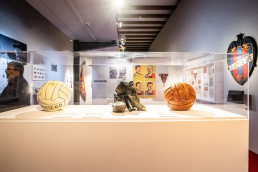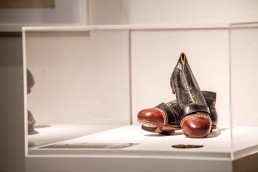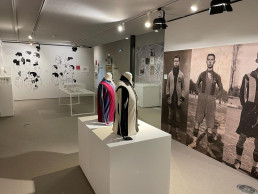At the beginning of the 20th century, the processes of urbanisation and industrialisation typical of the mass society that was beginning to develop gave rise to a series of social changes that led to an improvement in working conditions and the appearance of leisure time among the working classes, thus generalising attendance at shows and the practice of sport.
In the city of Valencia, the two pioneering teams were Levante F.C. and Gimnástico F.C., founded in 1909 in different neighbourhoods and with ideologically opposed social masses. Rivals for thirty years, history would end up uniting them, giving way in 1939 to the Unión Deportiva Levante-Gimnástico and, two years later, to the current Levante U.D. The name was given by Levante, the colours and the nickname “granota” came from Gimnástico, as its fans were known when they played in the Estadium Valenciano, located on the bed of the Turia. This curious history has given the club a peculiar and complex identity.
The exhibition, focused from an informative point of view, aims to show the milestones that have marked the history of the club. The exhibition allows us to get to know the founders of the teams, the fields where they played, the old shirts, the titles, the consequences of the Civil War, the merger, the relations between the players and the club…, until the first promotion to the First Division in the 1962-63 season, when the cat finally climbed the palm tree. This old team is today a modern club, a pioneer of women’s football and a standard bearer in the consideration of sport as a tool for social inclusion.
The exhibition is a production of L’ETNO, Museu Valencià d’Etnologia with the collaboration of Levante U.D. It is curated by José Vicente Aguilar and Asunción García, curators of L’ETNO and by Emilio Nadal and Borja Arce, both members of the Heritage Area of Levante U.D.. The exhibition is designed by Suso Pérez (Estudio Gimeno Gràfic). L’ETNO, in collaboration with the club, will develop a programme of cultural activities related to the exhibition: guided tours, lectures, book presentations, conferences, radio programmes and talk shows with current figures from the men’s and women’s teams.
The exhibition is organised chronologically in different sections:
Introduction. Sporting Valencia. It shows the sports and manifestations practised by Valencian society before the arrival and popularisation of football. With the improvement of working conditions and the spread of hygienist ideas that advocated sport as a health factor, various sports associated with the different social classes became popular, and their facilities became widespread throughout the city. Some of them still exist today: cycling (velodromes), pelota (pelota courts such as the Jai-Alai, trinquetes, such as the Pelayo), tennis, polo, horse-riding – typical of the wealthy classes – such as the nautical club, or the tennis club.
The origins of Levante U.D. The exhibition shows us the first years of the trajectory of the two teams of the city that, after their merger, would end up forming the current entity. Two teams with different social origins, with different ideological bases, with fields located in distant places and with different sporting trajectories. On the one hand, Levante, founded by a teacher (Vicente Ballester) who organised a team around a school for humble classes, in which sport, in this case football, played on the beach (in Cabanyal) complemented basic education. On the other hand, Gimnástico, which arose from the activity of the Patronato de la Juventud Obrera, the result of the work of integration developed by social Catholicism aimed at the lower strata of society, which over time disassociated itself from the Patronato, losing its more social component in favour of more affluent classes, which turned it into a powerful team with new sports sections such as fencing, athletics and cycling.
War and cup. At the beginning of the Civil War, competitions did not stop and the city’s clubs proclaimed themselves loyal to the Republic. In 1937, the division of the country into two zones prevented the state championships from being played and regional championships were played: the Mediterranean League and the Free Spain Cup. Many matches were also organised in the city of Valencia to pay tribute to and raise funds for the militias, hospitals and charities. Among the tournaments played in that year was the Cup, the final of which was played by Valencia FC and Levante FC, the latter team winning the title. Given that during Franco’s dictatorship this tournament was not recognised, the club and the political authorities, with the support of a large part of the fans and Valencian society, are fighting for this trophy to be recognised for Levante UD.
Merger in 1939. In 1939, at the end of the war, Gimnástico FC and Levante FC suddenly merged. Two teams that had been rivals, with antagonistic social masses, merged with the creation of the Unión Deportiva Levante-Gimnástico. Among the reasons for this merger was the need to bring together two entities that the war had treated unequally, but complementary: Levante had been left without a pitch and with good players and Gimnástico lacked stars, but had a pitch (Vallejo) in good condition. In addition to these conditions, there is also the idea that the merger was intended to form a new football entity in line with the new dictatorship’s guidelines.
Creation of Levante U.D. In 1941, with the same discretion and surprise that had created the UDLG, the team was renamed Levante Unión Deportiva and recovered the blue and maroon of Gimnástico as the team’s colours. The lack of roots of the team born of the merger influenced the decision to return, to a certain extent, to the origins. The new name and colour combination was an explicit recognition of the two teams and the two traditions that formed the team. The premiere took place in a friendly match against Real Madrid.
The rise to the elite. On 2 June 1963, Levante UD made a great dream come true, a dream pursued for decades: promotion to the First Division. After the failed attempts in 1940 and 1959, the cat was able to climb the palm tree. In the promotion promotion play-off they beat Deportivo de La Coruña in Riazor (1-2) and, in the second leg, in Vallejo, they won 2-1. More than 25,000 spectators witnessed this historic milestone. The promotion was a sporting and social event that permeated the life of the whole city of Valencia.



